
FS-1096 | January 2020
Alfalfa Weevil
A Pest of Early Season Alfalfa
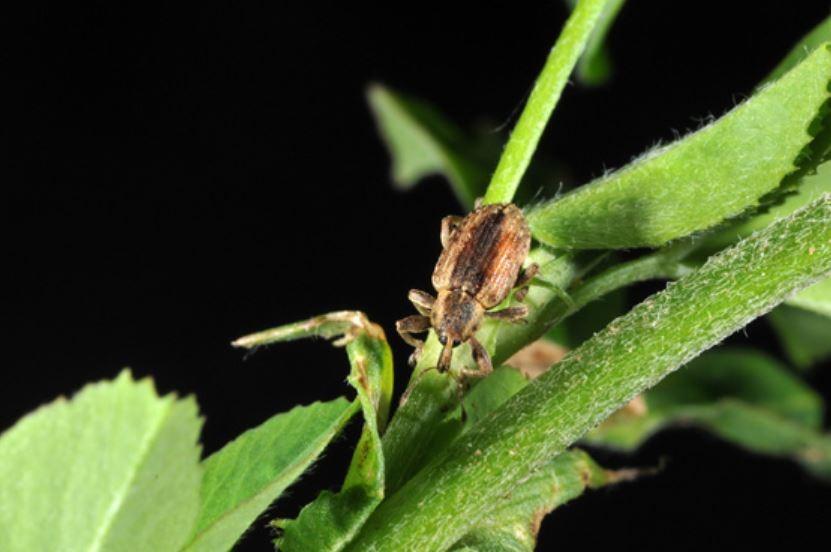
Alfalfa (Medicago sativa L.) is an important forage crop for dairy and beef cattle, swine, poultry, sheep, and horses.¹ In Maryland, alfalfa weevil, Hypera postica (Gyllenhal) (Coleoptera: Curculionidae), occasionally cause significant damage on susceptible cultivars.¹
Alfalfa weevil was first detected in Utah in 1904, and has since spread throughout the contiguous United States.² It was first detected in Maryland in 1951.³ Efforts to suppress alfalfa weevil populations in Maryland have been largely successful because of biological control, but continued monitoring and management programs are vital to avoid localized pest outbreaks.
Alfalfa Weevil is a Beetle and a Member of the Weevil Family Curculionidae

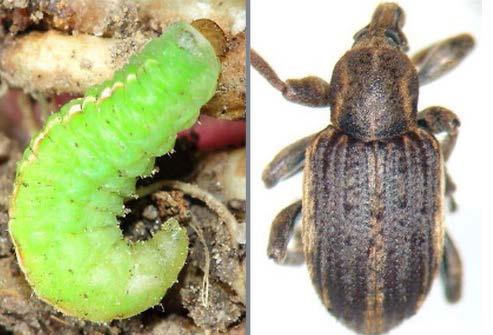
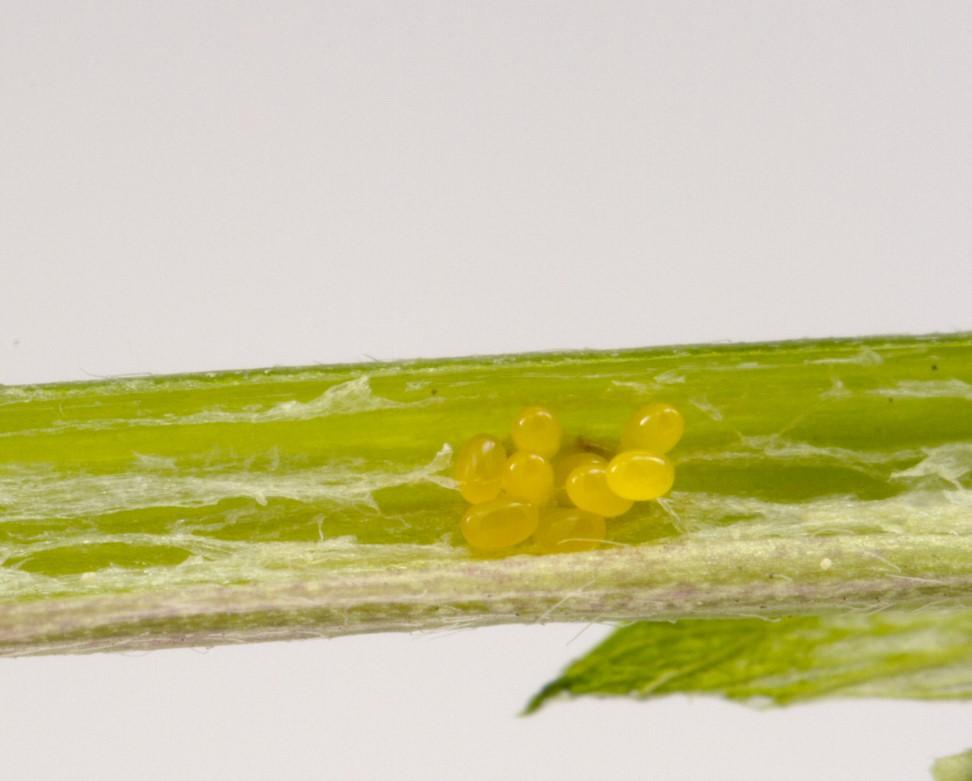
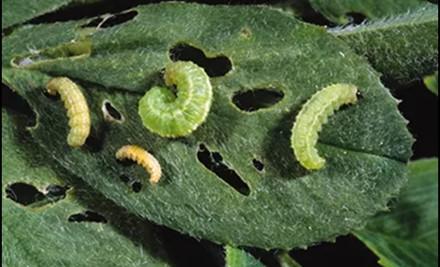
Alfalfa weevil adults have a distinctive snout, indicative of most weevil species, and brown bodies with a black dorsal stripe (Figure 1). Adults can reach ¼ inch in length.² Larvae are green with a black head and white dorsal stripe (Figure 2). Late instars (a developmental stage of insects) reach 8 mm in length.³
The clover leaf weevil, Hypera zoilus, is a co-occurring species that looks similar to alfalfa weevil. The clover leaf weevil adult, however, does not have the dorsal brown stripe and the larva has a brown head² (Figure 3).
The life cycle of alfalfa weevil in Maryland and states with similar climates usually consists of one full generation per year. Adults disperse in the fall and can lay eggs but generally a second larval generation does not occur in one year.² In the spring, adults emerge from overwintering sites and restart laying eggs. Adults oviposit 5-20 orange eggs in alfalfa stems (Figure 4). Due to fall and spring egg laying, two pulses of larvae may be seen in the spring, which can impact management decisions.³
First instar larvae emerge from the eggs after one to two weeks. In Maryland, alfalfa weevil larvae take about three weeks to progress through four instars (Figure 5) then they form silken cocoons and pupate at the base of the alfalfa plant or on alfalfa stems. Pupation can last one to two weeks before second-generation adults emerge in mid-June.⁴
Signs of Alfalfa Injury First Occur as Pinholes in Early Growth on Terminal Leaves of Alfalfa and Other Legumes, Such as White Clover
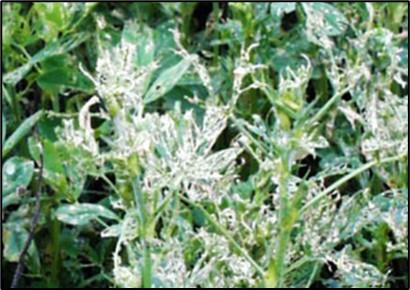
As larvae grow and molt, they consume more of the leaves. Injury is characterized by pinholes on the leaves of early alfalfa growth (Figure 5) and later as skeletonized leaves (Figure 6), which creates a white or gray appearance. With rapidly developing larvae and warm conditions, damage to a field can occur quickly. Based on its life cycle, most damage occurs on or just after the first harvest, although fall injury sometimes occurs.³ Forage quality can suffer from feeding due to reduced crude protein content or total digestible nutrients. Heavily damaged alfalfa can also be less competitive with weeds.²
Scouting and Monitoring for Alfalfa Weevil and the Injury it Causes is Vital to Forming a Timely and Economical Management Plan
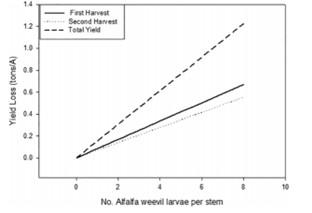
The number of alfalfa weevil larvae found on the first and second harvest of alfalfa can dramatically affect total alfalfa yield (Figure 7). Scouting for alfalfa weevil in Maryland should take place weekly from early April through early June.⁵
Two approaches that can be used to scout for alfalfa weevil are the sweep-net method or shake-bucket method. The method you will want to use depends on training and feasibility for your operation (Table 1). Both methods involve randomly selecting at least four areas of the field to sample.
| Sampling Method | Speed | Small Larvae Detection | Training | Plant Height Dependent |
|---|---|---|---|---|
| Shake-bucket | Slow | Yes | Low | No |
| Sweep-net | Fast | No | High | Yes |
For the shake-bucket approach, pick at least 30 stems and vigorously beat them against the side of a bucket. Scouts should record the number of stems, stem length, and the number of alfalfa weevil larvae in the bucket; they can then calculate the average number of larvae per stem.
The sweep-net approach involves using a canvas sweep net to sample foliage 20 times, counting and recording larvae, and then calculating average larvae per sweep. When sweeping, swing the net in a 180˚ arc and place the net halfway into the alfalfa foliage. Sampling early in the season is preferred because it allows detection of larvae before they mature and are able to cause economic damage.⁶ When the number of larvae exceeds economic threshold levels (Table 2), growers should actively manage the alfalfa weevil population by spraying insecticide or harvesting.
| Stand Height (Inches) | Indication of Problem (% Tip Feeding) | Problem Confirmation (Larvae per stem) | Recommended Action |
|---|---|---|---|
| 6 | 25 | 1 | Recheck in 7 days |
| 9 | 50 | >1 | Spray |
| 12 | 75 | >2 | Spray or Harvest |
| 16 | 100 | >4 | Harvest Early |
| When Harvested Early due to weevil, check within one week for regrowth. | |||
Alfalfa Weevil Control Options Can Be Either Preventative or Curative
Several options are available for alfalfa weevil control, and success with biological and cultural controls has resulted in reduced dependence on insecticides.
Preventative: Resistant cultivars of alfalfa are available. These varieties have more axillary buds and branches that withstand feeding. However, if infestations are heavy, other options may need to be deployed.³
Cultural: Depending on the size of operation, climate, and timing, livestock grazing, especially in spring and winter, or intercropping alfalfa with grasses are viable options for decreasing alfalfa weevil populations. Alternatively, an effective and popular cultural management option is to harvest the first cutting of alfalfa before significant damage occurs and before larvae complete development. This strategy can be effective because it can kill most larvae, causing fewer eggs to be laid by the second-generation adults.³
Biological: The United States Department of Agriculture’s Agricultural Research Service (ARS) and Animal and Plant Health Inspection Service (APHIS) released eight species of parasitoid wasps to control alfalfa weevil. Additionally, other natural enemies such as lady beetles (Coccinellidae), damsel bugs (Nabidae), lacewings (Chrysopidae), and some spiders prey on the vulnerable larval stage.³ Reduced use of insecticides in the area helps to preserve natural enemies.
Chemical: Insecticides for adult alfalfa weevils, larvae, or both are available. Apply organophosphates, carbamates, and pyrethroids for larval stages and organophosphates or pyrethroids for adults. It is important to apply insecticide to regrowth after the first cutting if larvae populations are at two or more weevils per stem.⁴ Be careful when applying insecticides, because alfalfa weevil insecticides are toxic to pollinators and natural enemies.³ Additionally, insecticide resistance can develop, which can cause insecticides to be less effective at reducing future pest populations.
You can find additional information regarding alfalfa management through the University of Delaware at https://www.udel.edu/academics/colleges/canr/cooperativeextension/
sustainable-production/pest-management/commercial-field-crop-pestmanagement/
alfalfa/ or Penn State University at https://ento.psu.edu/extension/factsheets/alfalfa-weevil.
References
- ¹Summers, Charles G. 1998. Integrated pest management in forage alfalfa. Integrated Pest Management Reviews 3(3): 127-154.
- ²Berberet, R.C. 2007. Weevils, in William O., R.C. Berberet, L.G. Higley, and C.R. Baird, eds. Handbook of Forage and Rangeland Insects. Entomological Society of America, Lanham, MD: 108-111.
- ³Pellissier, Makenzie E., Z. Nelson, and Randa Jabbour. 2017. Ecology and management of the alfalfa weevil (Coleoptera: Curculionidae) in western United States alfalfa. Journal of Integrated Pest Management 8(1): 5; 1-7.
- ⁴Whalen, J., and B. Cissel. 2016. Alfalfa Weevil Control in Alfalfa. University of Delaware.
- ⁵Lamp, William O., Gary R. Nielsen, and Galen P. Dively. 1991. Insect pest-induced losses in alfalfa: Patterns in Maryland and implications for management. Journal of Economic Entomology 84(2): 610-618.
- ⁶Hoff, Kimberly M., Michael J. Brewer, and Sue L. Blodgett. 2002. Alfalfa weevil (Coleoptera: Curculionidae) Larval sampling: Comparison of shake-bucket and sweep-net methods and effect of training. Journal of Economic Entomology 95(4): 748-753.
- ⁷Hammond, Ronald B., Andy Michel, and James B. Eisley. 2014. Alfalfa Weevil on Alfalfa. Ohio State University Extension.
MARGARET HARTMAN
mehartma@terpmail.umd.edu
This publication, Alfalfa Weevil (FS-1096), is a part of a collection produced by the University of Maryland Extension, Department of Entomology within the College of Agriculture and Natural
Resources.
The information presented has met UME peer-review standards, including internal and external technical review. For help accessing this or any UME publication contact: itaccessibility@umd.edu
For more information on this and other topics, visit the University of Maryland Extension website at extension.umd.edu
University programs, activities, and facilities are available to all without regard to race, color, sex, gender identity or expression, sexual orientation, marital status, age, national origin, political affiliation, physical or mental disability, religion, protected veteran status, genetic information, personal appearance, or any other legally protected class.